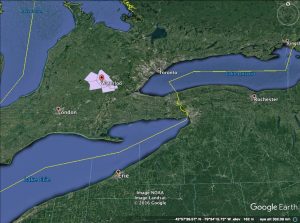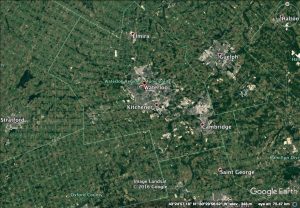WHY SNAPPING TURTLES?
The snapping turtle is the largest freshwater turtle in Canada, and while it is not endangered, it is listed as a species of “Special Concern” under the Ontario Endangered Species Act and Canada’s Species at Risk Act (Ontario Nature, 2016; Species at Risk Public Registry, 2016). In Canada, snapping turtles are found mainly in southern Ontario. Contributing to the threatened status of the snapping turtle is habitat loss, habitat fragmentation, predation, hunting, and traffic (Ontario Nature, 2016; Patrick, 2010; Species at Risk Public Registry, 2016).
In September 2016, Kitchener, Ontario opened an innovative artificial turtle nesting area, Turtle Park (Thompson, 2016). This inspired us to help expand snapping turtle protection efforts by focusing our analysis on the region of Waterloo. The region of Waterloo encompasses both urban and rural areas, allowing for a comprehensive analysis of turtle habitat preference in mixed-use areas.
THE WATERLOO REGION IN CONTEXT:

WATERLOO REGION: Urban and Agricultural Space

HABITAT
Snapping turtles spend most of their lives in shallow areas of freshwater, but migrate (sometimes very long distances) to coarse sandy soils to lay their eggs and mate (Gunson & Schueler, 2012; Paterson et al., 2012; Species at Risk Public Registry, 2016). For this reason, we will analyze nesting habitat separately from the other habitat areas. The ‘other’ habitat areas will be referred to as ‘hibernation habitat’.
Characteristics of Suitable Hibernation Habitat:
- proximity to freshwater habitat (Ontario Nature, 2016)
- shallow, slow moving rivers and lakes (Department of Energy and Environmental Protection; 2016; Ontario Nature, 2016)
Characteristics of Suitable Nesting Habitat:
- maximum sun exposure (south, southwest facing) (Smith, 2008; Toronto Zoo, n.d.)
- close proximity to freshwater habitat (Smith, 2008; Toronto Zoo, n.d.)
- substrate particle size: coarse sand or gravel (Smith, 2008; Toronto Zoo, n.d.)
Snapping turtles often lay their eggs in ditches and the sides of roads, which puts them at risk of injury or death by traffic (Richards, n.d.; Patrick, 2010). In the spring months, during nesting season, turtles may travel great distances to their preferred nesting habitat – which is incredibly dangerous in a region with many busy roads and highways. Therefore, we will also consider ‘distance from roads’ as another characteristic of suitable snapping turtle habitat.
Threats from development (habitat fragmentation, pollution etc) also indicate that we should additionally prioritize ‘natural’ areas (e.g. wetlands, forests etc.) over developed areas (buildings, golf courses, agricultural areas etc.) (Ontario Nature, 2016; Species at Risk Public Registry, 2016).
